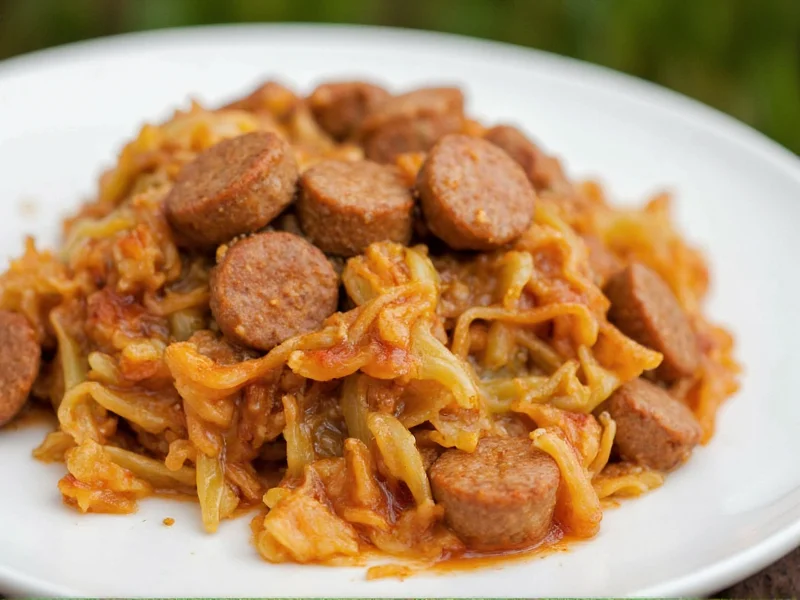This satisfying sausage cabbage casserole recipe has become a weeknight dinner staple for families seeking quick, budget-friendly meals without sacrificing flavor. The dish's origins trace back to Eastern European cuisine where cabbage features prominently in traditional cooking. What makes this casserole exceptional is how the natural sweetness of slowly cooked cabbage complements the smokiness of quality sausage, creating complex flavors with minimal ingredients.
Why This Sausage Cabbage Casserole Works
Unlike many casseroles that rely on heavy cream sauces or processed ingredients, this traditional preparation highlights the natural flavors of simple components. The magic happens through proper layering technique and controlled moisture levels—too much liquid creates a soggy casserole, while too little prevents the cabbage from tenderizing properly. Our tested method ensures perfectly textured cabbage that retains its shape while absorbing the sausage's rich flavors.
Essential Ingredients for Authentic Flavor
The beauty of this easy sausage cabbage casserole lies in its straightforward ingredient list. Quality matters most with the sausage selection—smoked kielbasa provides the ideal flavor profile, though you can substitute with smoked turkey sausage for a lighter option. Fresh green cabbage works best, though fermented sauerkraut makes an excellent alternative for more tangy results.
| Ingredient | Quantity | Substitution Options |
|---|---|---|
| Smoked sausage (kielbasa) | 1.5 lbs | Smoked turkey sausage, andouille sausage |
| Green cabbage | 1 medium head (2 lbs) | Sauerkraut (drained), savoy cabbage |
| Yellow onion | 1 large | Shallots, leeks |
| Caraway seeds | 1 tsp | Fennel seeds, dill seeds |
| Tomato paste | 2 tbsp | Crushed tomatoes, red wine |
Step-by-Step Preparation Guide
Follow these precise steps for the best sausage cabbage casserole results. Proper layering technique prevents sogginess while ensuring even flavor distribution throughout the dish.
- Prep ingredients: Slice sausage into 1/4-inch rounds. Shred cabbage using a sharp knife or food processor. Finely dice onion.
- Par-cook sausage: In a large skillet over medium heat, brown sausage pieces for 3-4 minutes until lightly crisped. Remove and set aside.
- Sauté aromatics: In the same skillet, cook onions until translucent (5 minutes), then add tomato paste and caraway seeds, cooking 1 minute until fragrant.
- Layer casserole: In a 9x13 baking dish, create alternating layers: 1/3 cabbage, 1/2 sausage, 1/2 onion mixture. Repeat, finishing with cabbage on top.
- Add moisture: Pour 1/2 cup broth or water around edges of dish—avoid stirring to maintain layers.
- Bake uncovered: At 375°F for 45-55 minutes until cabbage is tender and top layer shows golden brown edges.
Proven Cooking Variations
Customize this versatile casserole to suit dietary needs or flavor preferences while maintaining structural integrity:
- Vegetarian version: Replace sausage with smoked portobello mushrooms and add 1 tbsp liquid smoke for authentic flavor
- Low-carb adaptation: Use cauliflower rice instead of cabbage for similar texture with fewer carbs
- Creamy twist: Mix 1/2 cup sour cream with 1 egg and spread over casserole during last 15 minutes of baking
- Spicy kick: Add 1/2 tsp red pepper flakes with the caraway seeds for heat lovers
Serving and Storage Recommendations
This hearty casserole pairs perfectly with crusty bread for soaking up juices or a simple green salad for contrast. Leftovers maintain quality remarkably well due to the cabbage's natural preservative properties.
For optimal results when storing: cool completely before covering, refrigerate for up to 4 days, or freeze portions for up to 3 months. Reheat covered with foil at 325°F until internal temperature reaches 165°F. Avoid microwaving which can make the cabbage rubbery—oven reheating preserves texture best.
Troubleshooting Common Issues
Even experienced cooks encounter challenges with this traditional dish. Here's how to solve frequent problems:
- Excess liquid: If your casserole appears watery after baking, return to oven uncovered for 10-15 minutes to evaporate moisture
- Dry texture: Add 1/4 cup broth when reheating leftovers to restore moisture
- Bland flavor: Boost taste with 1 tsp apple cider vinegar or lemon juice before serving
- Soggy top layer: Broil for 2-3 minutes at end of cooking for crispier finish
Frequently Asked Questions
Can I use frozen cabbage in sausage cabbage casserole?
Yes, frozen cabbage works well but requires proper preparation. Thaw completely and squeeze out excess moisture using a clean kitchen towel. Frozen cabbage releases more liquid during cooking, so reduce added broth by 1/4 cup and increase baking time by 10-15 minutes to evaporate excess moisture.
How do I prevent my sausage cabbage casserole from becoming too watery?
To avoid a watery casserole, salt shredded cabbage and let it sit for 20 minutes before cooking, then squeeze out excess liquid. Use minimal added liquid (1/2 cup maximum), ensure sausage is properly browned to render fat, and bake uncovered for the final 15 minutes. Proper layering without stirring maintains structure and prevents excess moisture release.
What's the best type of sausage for traditional sausage cabbage casserole?
Smoked kielbasa provides the most authentic flavor for traditional sausage cabbage casserole. Look for Polish-style kielbasa with natural casings for best results. Andouille sausage makes a good alternative for those preferring spicier notes, while smoked turkey sausage works for lighter versions. Avoid sweet Italian sausage as its fennel flavor clashes with traditional caraway seasoning.
Can I make sausage cabbage casserole ahead of time?
Yes, assemble the casserole up to 24 hours in advance and refrigerate covered. When ready to bake, add 10-15 minutes to the cooking time since you're starting with a cold dish. For best texture, wait to add any creamy elements like sour cream topping until just before baking. The flavors actually improve with overnight resting as the cabbage absorbs the sausage flavors.
Is sausage cabbage casserole freezer-friendly?
Absolutely. Cool completely, then portion into airtight containers or freezer bags, removing as much air as possible. Freeze for up to 3 months. Thaw overnight in the refrigerator before reheating. For best results when reheating frozen portions, add 2-3 tablespoons of broth and cover with foil during the first 20 minutes of reheating at 325°F.











 浙公网安备
33010002000092号
浙公网安备
33010002000092号 浙B2-20120091-4
浙B2-20120091-4